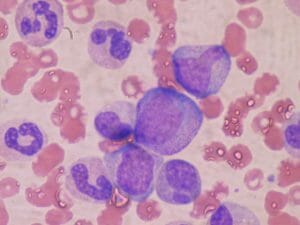The 206 bones in the human body have several functions that maintain homeostasis.
Mineral and Fat Storage
Bones serve as reservoirs for calcium and phosphorous. About 99% of the body’s calcium and 85% of the phosphorus are stored in the bones of the skeleton. Calcium is needed for muscle contraction and nerve impulse conduction. The amount in circulation must be kept tightly controlled inside a narrow range. If the concentration is too high or too low, these cells cannot function.
While the red marrow is where red and white blood cells and platelets are made, the yellow marrow stores fat in the form of triglycerides. This serves as a reservoir of quick energy that the body can use when needed.

The image above is a cross section of bone showing the red and yellow marrow inside.
Blood Cell and Platelet Production
The spongy bones of the body contain bone marrow that produces red blood cells to replace those that have reached the end of their life span and what is lost during bleeding and hemorrhaging. In addition, marrow is a lymphoid organ that generates lymphocytes such as natural killer cells, T cells, and B cells that are essential to the immune system and maintain good health. The bone marrow of the average human produces about 500 billion blood cells every day.
Platelets are also formed in the bone marrow. These tiny pieces of specialized tissue (they’re actually fragments of cells) are essential for blood clotting. In addition, platelets send chemical signals into the blood stream that attract other platelets to the site of a wound. They also activate other coagulation mechanisms in the body.

The image above shows red bone marrow with red and white blood cells in various stages of development.
Protection, Support, and Movement
The ribs surround and protect the lungs and the skull encases and protects the brain. Also, the spinal cord is protected by the vertebrae that surround it. Bones make it possible for the body to move and also provides support by being the attachment points for tendons which, in turn, attach to the muscles. Support and movement of the body is needed to hunt for food and fight off predators, both essential functions for maintaining homeostasis.
References
- OpenStax College. (2018). Anatomy & Physiology. Houston, TX. OpenStax CNX. Retrieved from http://cnx.org/contents/14fb4ad7-39a1-4eee-ab6e-3ef2482e3e22@8.119
